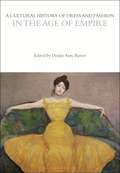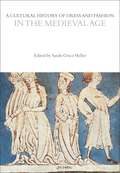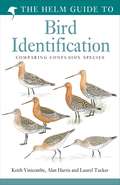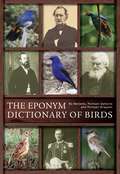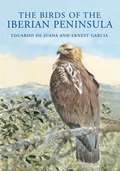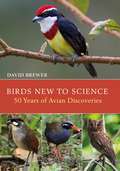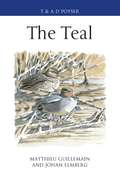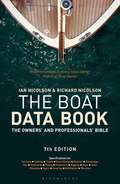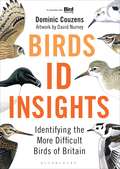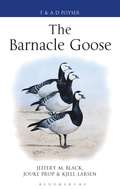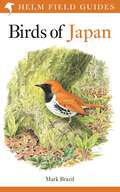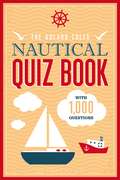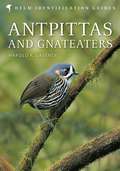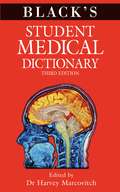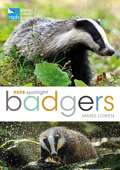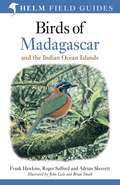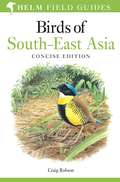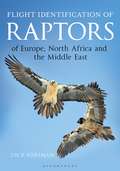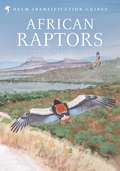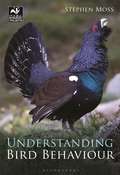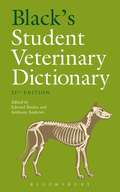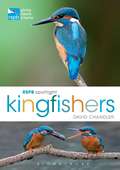- Table View
- List View
A Cultural History of Dress and Fashion in the Age of Empire (The Cultural Histories Series)
by Denise Amy BaxterDuring the nineteenth and early twentieth centuries the production of dress shifted dramatically from being predominantly hand-crafted in small quantities to machine-manufactured in bulk. The increasing democratization of appearances made new fashions more widely available, but at the same time made the need to differentiate social rank seem more pressing. In this age of empire, the coding of class, gender and race was frequently negotiated through dress in complex ways, from fashionable dress which restricted or exaggerated the female body to liberating reform dress, from self-defining black dandies to the oppressions and resistances of slave dress. Richly illustrated with over 100 images and drawing on a plethora of visual, textual and object sources, A Cultural History of Dress and Fashion in the Age of Empire presents essays on textiles, production and distribution, the body, belief, gender and sexuality, status, ethnicity, and visual and literary representations to illustrate the diversity and cultural significance of dress and fashion in the period.
A Cultural History of Dress and Fashion in the Medieval Age (The Cultural Histories Series)
by Sarah-Grace HellerDuring the medieval period, people invested heavily in looking good. The finest fashions demanded careful chemistry and compounds imported from great distances and at considerable risk to merchants; the Church became a major consumer of both the richest and humblest varieties of cloth, shoes, and adornment; and vernacular poets began to embroider their stories with hundreds of verses describing a plethora of dress styles, fabrics, and shopping experiences. Drawing on a wealth of pictorial, textual and object sources, the volume examines how dress cultures developed – often to a degree of dazzling sophistication – between the years 800 to 1450. Beautifully illustrated with 100 images, A Cultural History of Dress and Fashion in the Medieval Age presents an overview of the period with essays on textiles, production and distribution, the body, belief, gender and sexuality, status, ethnicity, visual representations, and literary representations.
A Cultural History of Dress and Fashion in the Age of Enlightenment (The Cultural Histories Series)
by Peter McNeilEighteenth-century fashion was cosmopolitan and varied. Whilst the wildly extravagant and colorful elite fashions parodied in contemporary satire had significant influence on wider dress habits, more austere garments produced in darker fabrics also reflected the ascendancy of a puritan middle class as well as a more practical approach to dress. With the rise of print culture and reading publics, fashions were more quickly disseminated and debated than ever, and the appetite for fashion periodicals went hand in hand with a preoccupation with the emerging concept of taste. Richly illustrated with 100 images and drawing on pictorial, textual and object sources, A Cultural History of Dress and Fashion in the Age of Enlightenment presents essays on textiles, production and distribution, the body, belief, gender and sexuality, status, ethnicity, and visual and literary representations to illustrate the diversity and cultural significance of dress and fashion in the period.
A Cultural History of Dress and Fashion in the Age of Enlightenment (The Cultural Histories Series)
by Peter McNeilEighteenth-century fashion was cosmopolitan and varied. Whilst the wildly extravagant and colorful elite fashions parodied in contemporary satire had significant influence on wider dress habits, more austere garments produced in darker fabrics also reflected the ascendancy of a puritan middle class as well as a more practical approach to dress. With the rise of print culture and reading publics, fashions were more quickly disseminated and debated than ever, and the appetite for fashion periodicals went hand in hand with a preoccupation with the emerging concept of taste. Richly illustrated with 100 images and drawing on pictorial, textual and object sources, A Cultural History of Dress and Fashion in the Age of Enlightenment presents essays on textiles, production and distribution, the body, belief, gender and sexuality, status, ethnicity, and visual and literary representations to illustrate the diversity and cultural significance of dress and fashion in the period.
A Cultural History of Dress and Fashion in the Renaissance (The Cultural Histories Series)
by Elizabeth CurrieSpurred by an increasingly international and competitive market, the Renaissance saw the development of many new fabrics and the use of highly prized ingredients imported from the New World. In response to a thirst for the new, fashion's pace of change accelerated, the production of garments provided employment for an increasingly significant proportion of the working population, and entrepreneurial artisans began to transform even the most functional garments into fashionable ones. Anxieties concerning vanity and the power of clothing to mask identities heightened fears of fashion's corrupting influence, and heralded the great age of sumptuary legislation intended to police status and gender through dress. Drawing on sources from surviving garments to artworks to moralising pamphlets, this richly illustrated volume presents essays on textiles, production and distribution, the body, belief, gender and sexuality, status, ethnicity, and visual and literary representations to illustrate the diversity and cultural significance of dress and fashion in the period.
The Helm Guide to Bird Identification
by Keith Vinicombe Alan HarrisThis ebook covers difficult identification issues by looking at tricky species pairs or groups of birds, and comparing and contrasting their respective features. Designed as a field companion, it supplements the standard field guides and provides much additional information. As well as detailed texts, the books include extensive illustrations of all relevant ages and plumages of the species concerned.
The Eponym Dictionary of Birds
by Bo Beolens Michael Watkins Michael GraysonBirdwatchers often come across bird names that include a person's name, either in the vernacular (English) name or latinised in the scientific nomenclature. Such names are properly called eponyms, and few people will not have been curious as to who some of these people were (or are).Names such as Darwin, Wallace, Audubon, Gould and (Gilbert) White are well known to most people. Keener birders will have yearned to see Pallas's Warbler, Hume's Owl, Swainson's Thrush, Steller's Eider or Brünnich's Guillemot. But few people today will have even heard of Albertina's Myna, Barraband's Parrot, Guerin's Helmetcrest or Savigny's Eagle Owl. This extraordinary new work lists more than 4,000 eponymous names covering 10,000 genera, species and subspecies of birds. Every taxon with an eponymous vernacular or scientific name (whether in current usage or not) is listed, followed by a concise biography of the person concerned. These entries vary in length from a few lines to several paragraphs, depending on the availability of information or the importance of the individual's legacy. The text is punctuated with intriguing or little-known facts, unearthed in the course of the authors' extensive research.Ornithologists will find this an invaluable reference, especially to sort out birds named after people with identical surnames or in situations where only a person's forenames are used. But all birders will find much of interest in this fascinating dictionary, an ebook to dip into time and time again whenever their curiosity is aroused.
The Birds of the Iberian Peninsula
by Eduardo De Juana Ernest GarciaThe Iberian Peninsula is one of Europe's most ornithologically varied regions offering a host of regional specialities. It includes famous birding hotspots such as the Coto Donaña wetlands, mountainous areas such as the Picos de Europa and the Pyrenees, the Mediterranean cork and holm oak forests of the southwest, the migration crossroads of the Strait of Gibraltar and the steppe-like plains of Extremadura and Alentejo. Large numbers of birders from around Europe visit the region to see this wealth of winged wildlife, but to date there has been no comprehensive regional avifauna in English.Birds of the Iberian Peninsula is a national avifauna that fills this gap in the ornithological literature. Full-colour throughout, the book begins with authoritative introductory chapters covering subjects such as geography, climate, habitats, the history of Iberian ornithology and the composition of the avifauna. The species accounts then cover every species recorded in mainland Spain, the Balearic Islands, Portugal, Gibraltar and Andorra, including the many vagrants. For each species there is detailed treatment of distribution – with maps of breeding and wintering ranges – habitat selection, population trends, historical and current status, migration and conservation.
Birds New to Science: Fifty Years of Avian Discoveries (Helm Photographic Guides)
by David BrewerAmazing as it might sound, ornithologists are still discovering several bird species each year that are completely new to science. These aren't all obscure brown birds on tiny islands – witness the bizarre Bare-faced Bulbul from Laos (2009), spectacular Araripe Manakin from Brazil (1998), or gaudy Bugun Liocichla from north-east India (2006).Birds New to Science documents more than half a century of these remarkable discoveries, covering around 300 species. Each account includes the story of discovery, a brief description of the bird (many with accompanying photographs), and details of what is known about its biology, range and conservation status.Written in an engaging style, this is a rich reference to an incredible era of adventure in ornithology.
The Teal
by Matthieu Guillemain Johan ElmbergSmall, noisy and colourful, the Teal is a familiar duck throughout the wetlands and waterways Europe and Asia. Once hunted extensively for the pot, its numbers have recovered and it is now one of our commonest species of waterfowl. A flagship species for wetland conservation, the Teal is also an excellent model species for ecological research, and this forms the spine of this new Poyser monograph. The Teal looks at distribution and trends in numbers, foraging ecology, breeding behaviour), population dynamics, management and conservation of teal, looking at both the Eurasian Common Teal and its North American equivalent, the Green-winged Teal (which until relatively recently was considered to be the same species). The book provides a scientifically robust account on which wetland managers, research scientists and the ornithological community may rely, with wider implicatons for the conservation and management of other waterfowl, and for ecological research in general.
The Boat Data Book: The Owners' and Professionals' Bible
by Richard Nicolson Ian NicolsonThe Boat Data Book is a treasure trove of invaluable information for boatowners, designers, builders, surveyors, chandlers and anyone maintaining their own boat.This seventh edition has been updated throughout and is now in colour for the first time. It contains more tables of lengths, widths, weights and strengths as well as new data on a vast range of equipment from anchors to masts, propellers to gas cylinders, cleat sizes to winch bases, and hatches to bolts, bearings, cabling and piping.If you want to know what size winch to fit, the breaking strength of stainless steel rigging wire, the recommended size for seacocks or what length and size an anchor chain should be, then this is the book for you. The Boat Data Book is a must-have reference for owners and professionals.'A veritable mine of information...superb value for money' Nautical Magazine'Recommended to every boat owner' Practical Boat Owner'A most amazing amount of data' The Island'The essential technical bible' Yachting World
Birds: Identifying the More Difficult Birds of Britain
by Dave Nurney Mr Dominic CouzensBirds: ID Insights is ideal for birders of all levels. Its unique layout, comparing the plumages of similar pairs and groups of species, makes it perfect for identifying the more difficult birds found in Britain and other parts of north-west Europe. It has more images showing how to age birds than any comparable guide, and its handy compact size makes it practical for taking out into the field.The book is based on a long-running series of identification features in Bird Watching magazine. Author Dominic Couzens and artist David Nurney have spent years compiling the field notes and artworks for this series, and here their efforts are drawn together and made complete in a single volume that is easy to carry in the field and practical for birders to use.In addition they have expanded the species list from the magazine series and added many new birds, including the likes of Subalpine Warbler, Short-toed Lark, and Red-rumped Swallow. in total, the book covers more than 230 species, with easy-to-identify species such as Magpie and Kingfisher given minimal coverage so that the more difficult ID issues can be covered as fully as possible.
The Barnacle Goose
by Jeffrey M. Black Jouke Prop Kjell LarssonThe Barnacle Goose, a distinctive, handsome black-and-white bird, gets its name from a mediaeval myth that the birds hatched from barnacles – how else to explain their sudden appearance each autumn in northern Britain? We now know, of course, that the birds migrate from Arctic Russia, Norway and Svalbard to winter throughout northern Europe. This book represents a culmination of more than 25 years of Barnacle Goose research. It represents the story of one of Europe's most celebrated long-term behavioral studies, detailing the lives of these social and sociable birds. Chapters include sections on pair formation and bonding, family and population dynamics, brood parasitism, food and feeding, size and shape in different populations, life cycle, survivorship, dispersal, migration, and conservation, with particular regard to climate change. It is a rigorous and thorough examination of the lives of these birds, in fine Poyser tradition.
Birds of Japan: China, Taiwan, Korea, Japan, And Russia (Helm Field Guides #46)
by Mark BrazilJapan is home to a spectacular and diverse range of birds, and this up-to-date text covers the identification, voice, habitat, behaviour and range of all the species and subspecies found across the beautiful and fascinating Japanese archipelago. The authoritative text is accompanied by superb full-colour plates painted by an expert artist and covers all major plumage variations. Birds of Japan will ensure that this top birding destination is made accessible to all.- The essential field guide to the region, covering 738 species and subspecies- 187 superb colour plates with detailed identification text and accurate colour distribution maps- Detailed illustrations of distinct subspecies, sexes, ages and morphs
The Adlard Coles Nautical Quiz Book: With 1,000 questions
by Bloomsbury PublishingThe Adlard Coles Nautical Quiz Book is perfect for seafaring quizzers. It's divided into six nautically-flavoured categories, covering 1,000 questions. Categories range from Geography, Famous people and History to Culture, Science and Trivia. Each round is graded as easy (Able Seaman), medium (Midshipman) or tough (Hard Tack). A random sprinkling of nautical 'did-you-knows' adds a little salt to the mix and there's a quick-fire section at the end to keep everyone on their toes. · In which ocean is the Bermuda Triangle? · What did Dee Caffari achieve in 2006? · Name the first vessel to reach the North Pole in 1958 · What does the god Neptune (aka Poseidon) carry? · What is the Saffir-Simpson scale? · What was the proper name of 'Bogie's Boat'? The Adlard Coles Nautical Quiz Book is the perfect stowaway for cosy evenings aboard or ashore.
Antpittas and Gnateaters
by Harold Greeney David BeadleElusive study organisms for ornithologists and highly prized additions to the birder's life-list, the antpittas (Grallariidae) and gnateaters (Conopophagidae) are among the most poorly known Neotropical bird groups. This authoritative handbook is the first book dedicated solely to these two families, combining an exhaustive review of more than two centuries of literature with original observations by the author and many knowledgeable contributors. Antpittas and Gnateaters provides a thorough guide to the identification and ecology of these birds, with detailed maps accompanying the text. A series of superb plates illustrate most of the 156 recognized taxa; supplemented by more than 250 colour photographs, the immature plumages and natural history of many species are depicted for the first time. This book is the ultimate reference on these remarkable and beautiful birds, and an indispensible addition to the libraries of researchers and birders for many years to come.
Black's Student Medical Dictionary
by Harvey MarcovitchBlack's Medical Dictionary has been the best-selling medical dictionary for over 100 years. It is invaluable as a home reference and for all who need clear explanation of medical terms: nurses, health care professionals, students, health service management, actuaries, lawyers and journalists. It contains over 5000 definitions and descriptions of medical terms and concepts with over 1000 diagrams, drawings and colour illustrations. It also provides helpful appendices on common medical tests and procedures, travel and health, measurements in medicine, health economics, complementary and alternative medicine, and an address list of supporting professional organisations. This new edition contains new material on: - HPV vaccine: the vaccine now given to all young girls to protect against cervical cancer - Monoclonal Antibodies: the `designer' drugs of the future - The new guidelines for fibroid treatment - Endoscopy and laparoscopy - the more and more widely used types of keyhole surgery - Coronary angioplasty: the emergency tretament of heart attacks - The latest on MRSA and stem cell research
RSPB Spotlight: Badgers (RSPB)
by James LowenBadgers are elusive wanderers of the night and few mammals are as mysterious. Their nocturnal lifestyle meansnot many of us have ever glimpsed their monochrome form as they sniff and bustle their way through woodland or across pasture – yet most of us live far closer to a Badger group than we might think. In Spotlight: Badgers James Lowen explores all aspects of their lives including their communal living, feeding habits, as well as the major threats to and conservation support for Badgers.These iconic omnivores are widely represented in folklore and have permeated our popular culture. Generations of children have been entranced by Badger in Kenneth Grahame's book Wind in the Willows, however these determined yet mostly peaceful animals have also been loathed and persecuted for centuries. Badger baiting is thankfully now illegal, but the legal badger cull introduced in 2011 in parts of Gloucestershire and Somerset remains in place following the 2015 general election. With so much politics surrounding Badgers in the UK, it's not easy to get unbiassed information. In RSPB Spotlight: Badgers James Lowen keeps a neutral tone on the debate about Badger culling. He describes the history, from the first Badger found to be infected with bTB in 1972 and the subsequent gassing of setts from 1975 to 1982. He also outlines the RSPB's stance on the Badger cull. As one of the UK's largest landowners, the RSPB oppose Badger culling on their land, in favour of vaccination, cattle testing, bio-security and movement controls.The Spotlight series introduces readers to the lives and behaviours of our favourite animals with eye-catching, colour photography and informative expert text.
Birds of Madagascar and the Indian Ocean Islands (Helm Field Guides)
by Roger Safford Adrian Skerrett Frank HawkinsThe Malagasy region contains one of the most extraordinary concentrations of biodiversity in the world. Its recognition as a zoogeographic region in its own right has recently been confirmed and, all taxa combined, the region was found to hold the second most distinct assemblage of vertebrates in the world after the Australian region, despite being the smallest of them all.This new field guide in the Helm Field Guides series covers the whole of the Malagasy region, which comprises the unique island of Madagascar and the various islands and archipelagos of the Indian Ocean including the Seychelles, Comoros and Mascarenes (Mauritius, Réunion and Rodrigues). Every resident and migrant species is covered in full detail with a colour distibution map for each species. Vagrants are also treated in detail, but without maps. All species are illustrated on a beautiful series of 124 colour plates, with artwork from John Gale and Brian Small. Conveniently, the plates have been arranged so that all the key species of the various archipelagos are placed together in sections.This is a major work of reference on the birds of the region and will remain the standard text for many years to come.
Birds of South-East Asia: Concise Edition
by Craig RobsonThe up-to-date text covers the identification, voice, habitat, behaviour and range of all the 1270 species and distinctive subspecies of this magnificent bird-rich region. The authoritative text is accompanied by over 140 full-colour plates painted by a range of expert artists and covering major plumage variations.Birds of South-East Asia is a complete field and reference guide to the birds of Thailand, Peninsular Malaysia, Singapore, Myanmar, Laos, Vietnam and Cambodia. It also covers a wide range of species found in the Indian subcontinent, China, Taiwan, Sumatra, Java, Bali, Borneo and the Philippines.
Flight Identification of Raptors of Europe, North Africa and the Middle East
by Dick ForsmanRaptors are notoriously hard to identify, even if seen well, and represent perhaps the toughest of all ID challenges for birders. This book is the ultimate flight-identification guide for the raptors of the Western Palaearctic, covering Europe, North Africa, the Middle East (including Arabia) to Central Asia. It provides identification information for all 60 species that regularly occur in the region, to subspecific level. The text covers every plumage and age in detail, with each species account accompanied by a range of photographs covering all the principal plumages.Based on this stunning photographic coverage, most of which has never been published before, this book represents a landmark in bird identification books and a major work for all raptor enthusiasts.
African Raptors (Helm Identification Guides)
by Bill Clark Rob DaviesThe most comprehensive guide to African raptors ever published.Africa has the most diverse range of raptors of any continent, with almost a third of the world's species occurring in the region. This comprehensive new book treats all of these species in impressive detail, with emphasis on their field identification. A full range of plumages is illustrated for each species, with artwork by raptor specialist Rob Davies. The authoritative text treats the identification of both perched and in-flight birds, and covers all major races, ages, plumages and morphs. These texts are accompanied by up-to-date distribution maps and a range of fabulous colour photographs from some of the world's leading bird photographers, again covering as broad a range of ages and subspecies as possible. This new Helm Identification Guide will be an essential reference for all birders and ornithologists with an interest in raptors.
Understanding Bird Behaviour
by Stephen MossThe way birds behave is one of the vital keys to accurate identification and this book provides the experienced instruction needed to understand and get the most out of watching birds. The guide covers all the fundamental types of bird behaviour, including movement, feeding, breeding, migration, navigation, distribution, range, life and death, all of which are illustrated with beautiful photographs. There is a whole section dedicated to the behaviour of different species groups, from divers and grebes through to sparrows, buntings and finches.
Black's Student Veterinary Dictionary
by Edward Boden Anthony AndrewsA paperback edition for the student market, this standard work of reference has been a bestseller for over 70 years. It is an essential tool for anyone with a professional or leisure interest in the care of animals. Much more than a list of veterinary terms, its practical approach ensures that readers gain an insight into the signs and symptoms of common, and less common, diseases, as well as their diagnosis and treatment. For this edition much new and updated information has been included, reflecting the numerous developments that have taken place in animal care and husbandry, and welfare. There is greatly expanded coverage of topics relating to popular breeds of dog and cat, and the inheritable conditions that might affect their health. Advances in medicine, surgery and diagnostic techniques; descriptions of newly identified diseases such as Schmallenberg virus; the resurgence of old scourges such as TB in cattle, and ongoing enzootic infections such as bird flu are also included in this edition. The growing risk of exotic diseases such as heartworm being imported following the relaxation of travel arrangements for dogs and cats is reflected in new entries. Notes on many new species being farmed or kept as companion animals are among the thousands of topics covered.
RSPB Spotlight Kingfishers
by David ChandlerUsually observed as a flash of blue and orange from a riverbank, most people are aware of Kingfishers, but few of us are familiar with the intricacies of their day-to-day lives.With their long, dagger-like bills, bright blue plumage and characteristic fast, low flight over water, Common Kingfishers are instantly recognisable. The 90 or so species that belong to this colourful family have a cosmopolitan distribution and, in Spotlight Kingfishers, David Chandler celebrates their remarkable existence, studying their unique adaptations and their courtship, breeding and feeding habits. He also investigates historical threats to Kingfishers, considers their future, and offers practical advice on how to find and see these glorious birds.
